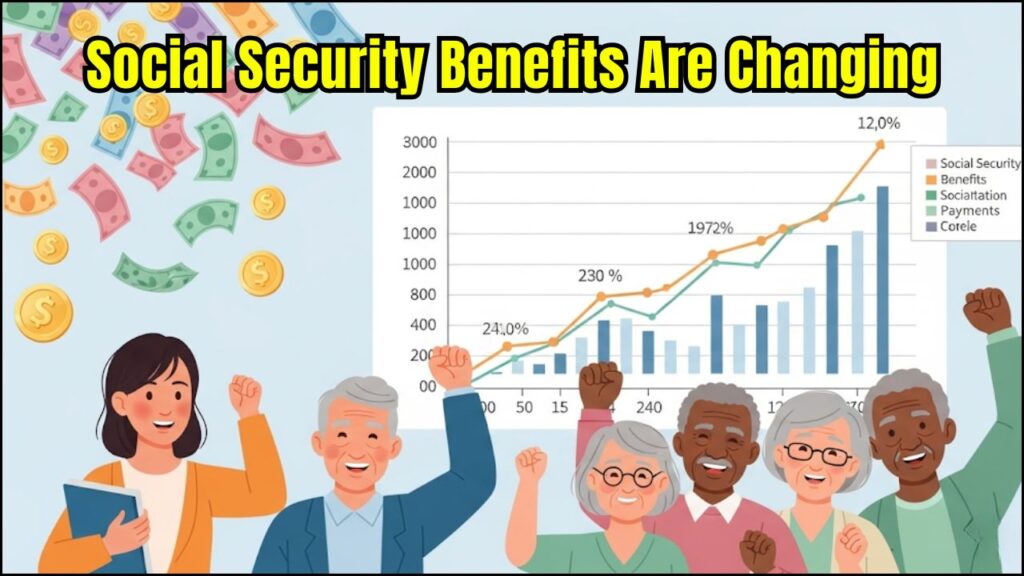If you’ve been wondering about the recent Social Security changes in 2025 and what they mean for your money, you’re not alone. Whether you’re nearing retirement, already collecting benefits, or planning for the future, these changes will affect millions of Americans—and it pays to know what’s coming.

In this guide, we’ll break everything down in plain English. We’ll talk COLA increases, earnings limits, tax impacts, and even some new laws that might boost your monthly check. We’ll also explore expert tips, interactive tools, real-world examples, and stories from everyday Americans to make it both engaging and actionable. So grab your coffee, settle in, and let’s make sure your wallet is ready for what’s next.
Social Security Benefits Are Changing
| Topic | Details |
|---|---|
| COLA Increase for 2025 | 2.5% increase, average monthly benefit rises ~$50 |
| SSI Maximums | $967 for individuals, $1,450 for couples |
| Taxable Earnings Cap | Rises to $176,100 in 2025 |
| Earnings Limit (Under FRA) | $23,400/year before benefits are reduced |
| Fairness Act Repeals WEP/GPO | Could mean $300+ more per month for public sector retirees |
| Medicare Premium Watch | Projected Part B premium increase to $185.00/month |
| Official Source | SSA.gov |
The 2025 changes to Social Security are a mixed bag: a modest raise from COLA, tax cap increases for higher earners, new flexibility for working retirees, and a major win for public sector pensioners. While the long-term future of the program is uncertain, one thing is clear: understanding these updates can help you make smarter money moves.
Stay informed, plan ahead, and don’t leave money on the table. The more you know, the better your retirement can be.
What Is Social Security and Why It Matters
Let’s start with the basics. Social Security is a federal program that provides monthly payments to retired workers, disabled individuals, and survivors. Think of it like a safety net you’ve been paying into your whole life through payroll taxes.
It’s a lifeline for over 67 million Americans each month—and for about 40% of retirees, it’s their only or primary source of income. So yeah, when Social Security changes, everyone pays attention.
“For me, Social Security is the difference between just getting by and actually being able to live,” says Elaine G., a 73-year-old retiree from Tulsa, OK.
COLA Is Going Up (But Just a Little)
What Is COLA?
Cost-of-Living Adjustment (COLA) is basically a yearly pay raise to help Social Security checks keep up with inflation. It’s tied to the Consumer Price Index for Urban Wage Earners and Clerical Workers (CPI-W).

What’s the 2025 Increase?
In January 2025, benefits are going up by 2.5%. That means the average retiree will see their check rise from $1,927 to $1,976. That’s about $50 more per month.
Is That Enough?
Good question. With inflation still impacting groceries, gas, and housing, a 2.5% boost may not stretch far. Still, it’s better than nothing—and it’s automatic. You don’t have to apply for it.
Tool Tip: Use the COLA Calculator on SSA’s website to estimate your own benefit increase.
SSI Gets a Boost Too
If you’re on Supplemental Security Income (SSI), your federal max monthly payment will increase to $967 for individuals and $1,450 for couples. Remember, this doesn’t include state supplements, which vary.
This change kicks in December 31, 2024, just before the new year.
You Might Pay More in Taxes (High Earners, Listen Up)
Taxable Wage Cap Is Rising
The amount of your income that’s subject to Social Security tax is increasing. In 2024, that cap was $168,600. In 2025, it’ll be $176,100.
If you make above that, those extra dollars aren’t taxed for Social Security. But if you’re under the cap? You’ll pay 6.2%, and your employer matches it. Self-employed folks pay the full 12.4%.
Heads Up for Employers and Contractors
More earnings taxed = higher payroll costs. If you’re a business owner, this change matters for budgeting.
Example: If you earn $175,000, you’ll pay an additional $457.20 in Social Security taxes in 2025.
Still Working? There Are Limits
What If You Work While Getting Benefits?
If you’re under Full Retirement Age (FRA) and working, there’s an income limit. In 2025, it’s $23,400/year. Go over that, and the SSA will withhold $1 for every $2 you earn above the limit.
If you hit FRA in 2025, the limit goes up to $62,160, and the penalty drops to $1 for every $3 earned above that.
Once you hit FRA? No more earnings limits. Work all you want and still collect full benefits.
Big Win for Public Sector Retirees: WEP and GPO Repealed
What Are WEP and GPO?
The Windfall Elimination Provision (WEP) and Government Pension Offset (GPO) used to reduce Social Security for people who also received public pensions. That includes retired teachers, firefighters, and police officers.
What’s Changed?
The Social Security Fairness Act, passed in early 2025, repealed both rules. That means thousands of retirees could see $100–$400/month more in their checks.
You don’t have to apply—the SSA will recalculate your benefits automatically.
Real Life: Sam M., a retired firefighter in Colorado, says his benefit jumped by $325/month since the repeal.
Long-Term Worries: Is Social Security Running Out?
The Trust Fund Issue
Yeah, we’ve gotta talk about it. The Social Security Trust Fund is projected to be depleted by 2033 or 2034, according to the latest SSA report. Without action, benefits could get cut by up to 26%.
Lawmakers are looking at options:
- Raising the payroll tax cap
- Gradually increasing the retirement age
- Reducing benefits for high earners
- Introducing private investments
No changes have passed yet, but keep your eyes open.
Early vs. Full vs. Delayed Retirement Benefits
Deciding when to claim your Social Security benefits is a big choice! Here’s how waiting can impact your monthly payout:
| Claiming Age | Benefit Impact | Important Notes |
| Age 62 (Early) | Reduced benefits (e.g., ~30% reduction for those born in 1960) | Your monthly payment will be permanently lower. There’s an earnings limit if you’re still working. |
| Full Retirement Age (FRA) | 100% of your Primary Insurance Amount (PIA) | This is your “sweet spot” for receiving your full, unreduced benefit. The FRA depends on your birth year (e.g., 66 and 10 months for 1959, 67 for 1960+). The earnings limit no longer applies once you reach your FRA. |
| Age 70 (Delayed) | Increased benefits (up to 8% per year past FRA) | You earn “delayed retirement credits,” significantly boosting your monthly payment. This increase stops at age 70, so there’s no additional benefit to waiting longer. This is often the maximum possible monthly benefit. |
What You Can Do Right Now
1. Check Your Earnings Record
Visit SSA.gov and create a my Social Security account. Make sure your income history is accurate—that’s what your future benefits are based on.
2. Know Your Full Retirement Age
It’s not 65 anymore! For most people retiring now, it’s between 66 and 67. You can claim early at 62, but your check will be smaller forever.
3. Consider a Financial Advisor
With changes coming fast, it’s worth getting professional advice. A certified financial planner (CFP) can help you maximize benefits and minimize taxes.
4. Explore State Benefits
Many states offer additional support programs for seniors, from utility assistance to prescription drug help. Check out BenefitsCheckUp.org to find out what’s available in your zip code.
FAQs
Q: Will Social Security run out of money?
A: The trust fund may run low by 2033–34, but taxes will still fund about 75% of benefits. Congress is expected to act before full depletion.
Q: How do I know if I’m affected by the WEP or GPO repeal?
A: If you received a public pension and reduced Social Security, you likely were. Contact SSA to review your case.
Q: Can I still work and get Social Security?
A: Yes—but if you’re under Full Retirement Age, your benefits may be reduced based on how much you earn.
Q: Do I need to apply for the 2025 COLA increase?
A: Nope. It’s automatic. You’ll see it in your January check.
Q: Is SSI the same as Social Security?
A: Not exactly. SSI is for those with limited income and resources. Social Security is based on work history.












